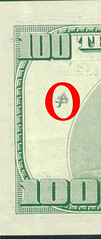
About UsThe Numismatic Bibliomania Society is a non-profit organization promoting numismatic literature. For more information please see our web site at coinbooks.org SubscriptionsThose wishing to become new E-Sylum subscribers (or wishing to Unsubscribe) can go to the following web page link MembershipThere is a membership application available on the web site Membership Application To join, print the application and return it with your check to the address printed on the application. Membership is only $15 to addresses in the U.S., $20 for First Class mail, and $25 elsewhere. For those without web access, write to: David M. Sundman, Treasurer AsylumFor Asylum mailing address changes and other membership questions, contact David at this email address: dsundman@LittletonCoin.com SubmissionsTo submit items for publication in The E-Sylum, just Reply to this message, or write to the Editor at this address: whomren@gmail.com
BUY THE BOOK BEFORE THE COIN |
- WAYNE'S WORDS: THE E-SYLUM FEBRUARY 16, 2014
- KREINDLER LIBRARY PART II PRICES REALIZED AVAILABLE
- NEW BOOK: HANDBOOK OF COINS OF BAKTRIA AND ANCIENT INDIA
- NEW BOOK: EISENHOWER APPRECIATION MEDALS
- ENCYCLOPEDIA OF MORGAN AND PEACE DOLLARS SUPPLEMENTS
- BOOK REVIEW: MONEY OF THE BIBLE, 3RD EDITION
- MORE ADVENTURES IN NUMISMATIC SELF-PUBLISHING
- THE UNIVERSAL RARITY SCALE
- NOTES FROM E-SYLUM READERS: FEBRUARY 16, 2014
- ST. LOUIS BUSINESS JOURNAL INTERVIEW ERIC NEWMAN
- MEL WACKS' TURKEY COUNTERSTAMP
- 2014 MEDAL COLLECTORS OF AMERICA MEDAL
- MORE ON RUTH HILL
- A DEFENSE OF BRAD TROEMEL'S EBAY ART PROJECT
- WAYNE'S NUMISMATIC DIARY: FEBRUARY 16, 2014
- TOM KAYS' NUMISMATIC DIARY: FEBRUARY 16, 2014
- COIN CATALOGUERS AND COMPANY STYLE SHEETS
- HOWARD GIBBS INFORMATION SOUGHT
- THE 2014 TRIAL OF THE PYX
- SOME NEW COIN DESIGNS: FEBRUARY 16, 2014
- CHOPMARKS ON MODERN U.S. PAPER MONEY
- 2015 AMERICA THE BEAUTIFUL COIN DESIGNS
- COMMEMORATIVES AND RELATED SO-CALLED DOLLARS
- SOTHEBY'S TO SELL BRITISH GUIANA ONE-CENT MAGENTA STAMP
- OSAMA BIN LADEN BANKNOTE
- ARTHUR HARRISON'S VICTORIA CROSS
- FEATURED WEB PAGE: LOVE TOKENS
Click here to access the complete archive
To comment or submit articles, reply to whomren@gmail.com
WAYNE'S WORDS: THE E-SYLUM FEBRUARY 16, 2014

New subscribers this week include Bill Harkins and Richard Ziegler, courtesy of Bob Fritsch; Chip Howell, Don Merritt, Lisa J. McLaughlin, Steve Marks, and BT Arnett. Welcome aboard! We have 1,704 email subscribers - a new milestone!
This week we open with an update from Kolbe & Fanning, two new numismatic books, and a review of Money of the Bible. Other topics include the Universal Rarity Scale, Ruth Hill, coin cataloguers, and the Trial of the Pyx.
To learn more about Eisenhower appreciation medals, Mel Wacks' turkey counterstamp, Alex Shagin's latest medal, the Queen’s Remembrancer, the famous Byron S. Loutzenhiser county coroner token, and what Eric Newman paid for $23 million of rare coins, read on. Have a great week, everyone!
Wayne Homren
Editor, The E-Sylum
KREINDLER LIBRARY PART II PRICES REALIZED AVAILABLE
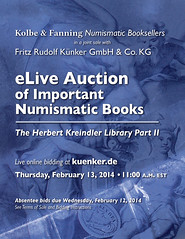 Kolbe & Fanning Numismatic Booksellers and Fritz Rudolf Künker GmbH & Co. KG jointly held an online eLive auction of the second part of the outstanding and comprehensive library on ancient numismatics formed by New York coin dealer Herbert Kreindler on Thursday, February 13. The sale brought exceptionally strong prices, attesting to continued demand for both standard references and rare and out-of-print titles.
Kolbe & Fanning Numismatic Booksellers and Fritz Rudolf Künker GmbH & Co. KG jointly held an online eLive auction of the second part of the outstanding and comprehensive library on ancient numismatics formed by New York coin dealer Herbert Kreindler on Thursday, February 13. The sale brought exceptionally strong prices, attesting to continued demand for both standard references and rare and out-of-print titles.
Aggressive bidding from clients around the world resulted in record prices for many works, especially classic auction catalogues. Many lots sold for multiples of the estimates; overall, the sale realized 112,981€ (approximately $154,000 on a pre-sale estimate of $72,900): an amazing 212% of estimate.
For more information, or to download the full prices realized list, see the Kolbe & Fanning website at www.numislit.com.
NEW BOOK: HANDBOOK OF COINS OF BAKTRIA AND ANCIENT INDIA
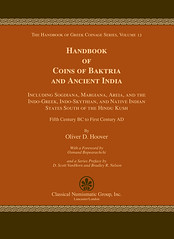 Hoover, Oliver D. Handbook of Coins of Baktria and Ancient India, Including Sogdiana, Margiana, Areia, and the Indo-Greek, Indo-Skythian, and Native Indian States South of the Hindu Kush, Fifth Century Centuries BC to First Century AD [The Handbook of Greek Coinage Series, Volume 12]. 2013. lxxxiv and 389 numbered pp. Hardbound. (GR, OG, CA) (GR 341)
Hoover, Oliver D. Handbook of Coins of Baktria and Ancient India, Including Sogdiana, Margiana, Areia, and the Indo-Greek, Indo-Skythian, and Native Indian States South of the Hindu Kush, Fifth Century Centuries BC to First Century AD [The Handbook of Greek Coinage Series, Volume 12]. 2013. lxxxiv and 389 numbered pp. Hardbound. (GR, OG, CA) (GR 341)
More than three decades have passed since David Sear published Greek Coins & Their Values, his revision of Gilbert Askew’s A Catalogue of Greek Coins published by B. A. Seaby in 1951. Since then, the field of ancient numismatics and the hobby of collecting ancient coins have changed so much that now Greek Coins & Their Values would require a complete revision to include all of the most current numismatic information available, list the many new types and varieties unknown to Sear, and determine an approximate sense of rarity for all of these issues.
In order to encompass this new material and create a viable reference for the beginning and specialized collector, such a handbook would have to be more than the two volumes which Sear found necessary. As a result, Classical Numismatic Group is publishing The Handbook of Greek Coinage Series, written by Oliver D. Hoover, in a series of 13 volumes, each covering a specified area of Greek coinage with the first being The Handbook of Syrian Coins: Royal and Civic Issues, Fourth to First Centuries BC (Volume 9 in the series).
This series is designed to aid the user in the quick, accurate, and relatively painless identification of Greek coins, while providing a cross-reference for each entry to a major work, which will allow the inquirer to pursue more in-depth research on the subject. The subject-matter of each volume is arranged chronologically for royal issues, and regionally for the civic issues; within each region, cities are listed directionally, depending on the region. For those rulers or cities that issued coins concurrently in all three metals, these issues will be arranged in the catalog with gold first, followed by silver, and then bronze; each metal is arranged by denomination, largest to smallest.
Known mints for the royal coinage are listed below the appropriate type, making an easy search for a specific mint. Each entry will include a rarity rating based on the frequency with which they appear in publications, public and private collections, the market, and/or are estimated to exist in public or private hands. No valuations are listed, since such values are generally out of date by the time of publication. An online valuation guide at www.greekcoinvalues.com will allowing interested individuals the opportunity to gauge the market, and reduce the need for repeated updates of this series. Whether one purchases the entire set for their reference library, or the individual volume pertaining to one’s area of specialization, The Handbook of Greek Coinage Series should provide a useful staging-point from which collectors and interested scholars can pursue their research and interests.
The latest published volume in the series is Handbook of Coins of Baktria and Ancient India, Including Sogdiana, Margiana, Areia, and the Indo-Greek, Indo-Skythian, and Native Indian States South of the Hindu Kush, Fifth Century Centuries BC to First Century AD (Volume 12 in the series). Beginning with the Kingdom of Baktria, the catalog covers all the Graeco-Bacrian and Indo-Greek kings. This volume includes the Indo-Skythian rulers and satraps, as well as the local coinages of the region. The Indian coinages south of the Hindu Kush are also included. While not obviously Greek coinage, these issues were struck in the context of their Greek neighbors and will add further evidence to the complex monetary systems of the region.
For more information or to order a copy, see: Now at Press - Orders Being Taken (www.cngcoins.com/Coin.aspx?CoinID=245635#)
To read the CoinsWeekly article, see: New volume in Handbook of Greek Coinage Series (www.coinsweekly.com/en/News/4?&id=2596)
NEW BOOK: EISENHOWER APPRECIATION MEDALS
 Under direction from the White House, 17 different medals were stuck by the US Mint in Philadelphia for use by President Eisenhower. Both Gilroy Roberts and Frank Gasparro had designed the medals. This book is the first to define/document the Dwight D. Eisenhower (D.D.E.) 17 medal series.
Under direction from the White House, 17 different medals were stuck by the US Mint in Philadelphia for use by President Eisenhower. Both Gilroy Roberts and Frank Gasparro had designed the medals. This book is the first to define/document the Dwight D. Eisenhower (D.D.E.) 17 medal series.
President Eisenhower presented these medals to deserving individuals in thankful recognition for service to our nation, the White House, or the Presidency. These appreciation medals have the distinction of being handed out by President Eisenhower himself or by his direction through military aides. This Presidential provenance limits availability to collectors as these medals are treated as presidential heirlooms by the original recipients' families.
There are three classes of the medals: US Half-Dollar Size, US Silver Dollar size, and Inaugural Medal size. Each of the 17 medals have been cataloged as DDE-01 through DDE-017. A total of 9,858 medals were struck at the US Mint in Philadelphia. 1,451 medals were destroyed before the end of President Eisenhower’s 2nd term in office. 160 medals are part of the D.D.E. Presidential Library. A USSR, Philippines, Formosa, and Alaska medals were originally ordered and later cancelled.
This book titled The Dwight D. Eisenhower Appreciation Medals, by Darryl A. Gomez, reveals the medal’s history and identifies the 17 different Dwight D. Eisenhower appreciation medals, their mintage, and most importantly the number destroyed at the end of President Eisenhower’s second term in office.
This book fills-in the knowledge gap about the Dwight D. Eisenhower appreciation medals for coin collectors and political memorabilia collectors.
This auction is for the book The Dwight D. Eisenhower Appreciation Medals that is signed by the author, with a personalized message made out to the auction winner, and numbered.
This book is also available for sale through other online distribution channels (but without the author's signature).
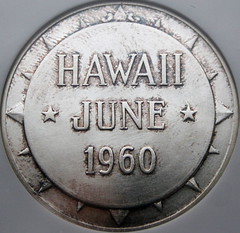
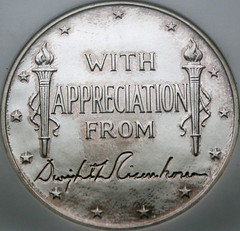
To view the complete eBay listing, see: Hawaii Medal - First book about the Eisenhower Appreciation Medals (www.ebay.com/itm/Hawaii-Medal-First-book-about-the-Eisenhower-Appreciation-Medals-/171244117215)
ENCYCLOPEDIA OF MORGAN AND PEACE DOLLARS SUPPLEMENTS
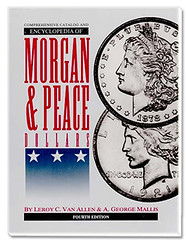 LeRoy Van Allen, the only surviving member of the numismatic research and writing partnership that spawned generations of Morgan and Peace dollar variety collectors, has published two supplements to the 1997 Fourth Edition of the Comprehensive Catalog and Encyclopedia of Morgan and Peace Dollars.
LeRoy Van Allen, the only surviving member of the numismatic research and writing partnership that spawned generations of Morgan and Peace dollar variety collectors, has published two supplements to the 1997 Fourth Edition of the Comprehensive Catalog and Encyclopedia of Morgan and Peace Dollars.
The first supplement, covering the Peace dollar series (1921-1935), spans 57 pages and contains 241 photos of coins discovered or revised in 2012 and 2013, when interest in the series was rekindled, mostly due to research and new discoveries by Dr. David Close, who was responsible for nearly 200 of the new listings.
The Peace dollar supplement may be purchased at a cost of $9 plus $3 postage and handling directly from Van Allen at:
Leroy Van Allen PO Box 196 Sidney, OH 45365
Released at the same time is Van Allen’s New VAM Varieties of Morgan Dollars which covers all discoveries within the Morgan dollar series from 1992 through December 2013.
The update contains 146 pages and 363 photographs of coins that were listed in 2013.
The Morgan dollar supplement is $12 plus $3 for postage and handling. Both books may be bought for $19 and $6 for postage and handling.
To read the complete article, see: Van Allen Publishes Two Supplements to the Encyclopedia of Morgan and Peace Dollars (www.coinweek.com/books-2/van-allen-publishes-supplement-encyclopedia-morgan-peace-dollars/)
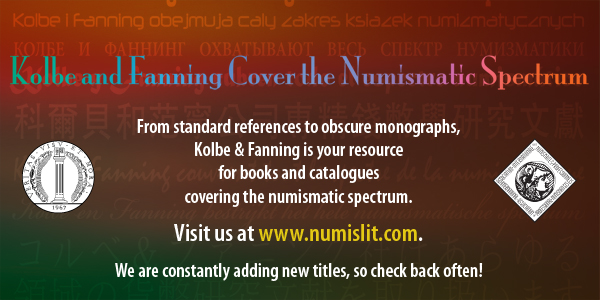
BOOK REVIEW: MONEY OF THE BIBLE, 3RD EDITION
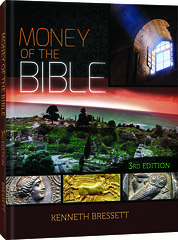 The latest edition of this classic reference has been available since August 2013.
The 120-page large-format book by Ken Bressett is hardbound with a glossy color dust jacket.
The press release summed it up well as follows:
The latest edition of this classic reference has been available since August 2013.
The 120-page large-format book by Ken Bressett is hardbound with a glossy color dust jacket.
The press release summed it up well as follows:
“Money and coins are mentioned many times, and in many places, in the Old and New Testaments,” Bressett said. “They give us a running commentary on biblical events in a way that no other artifacts can supply.” He presents their stories and explores their relevance in the updated third edition of Money of the Bible, which includes expanded text and many additional and upgraded photographs.
In Money of the Bible he studies how the Bible was written, and its nature; commerce before coins; coins of Old Testament times; coins in the New Testament; first-century money and trade; coins mentioned in Jesus’ parables and lessons; coins and the Passion of Christ; the beginning and spread of Christianity; and how to collect coins with Biblical themes. A detailed index of terms and Bible verses rounds out the text and its full-color photographs.
The opening chapter is a useful lesson in ancient writing, describing the physical forms in which the stories of the Bible were recorded and handed down through history. Clay tablets and scrolls (such as the famous Dead Sea Scrolls), along with the work of thousands of scribes, helped ensure the survival of these precious 66 books by 40 authors over a period of about 1,600 years. Chapter Two is a brief overview of the nature and languages of the Bible together with an illustrated overview of the history of the ancient world.
Chapter Three provides background on "Commerce Before Coins". Before coins came along people made do with barter and the exchange of silver, gold and other precious metals in jeweler and other forms. Illustrated are early bronze ingots and ancient lumps of electrum, a raw mixture of silver and gold.
The "Coins of Old Testament Times" (Chapter 4) opens the discussion of coins of Bible days. The earliest coins mentioned in the Bible are gold darics of the Persian King Darius I (illustrated earlier on p15). Illustrations here include a silver half stater of Lydia and silver sigoli of the Persian Empire. Here (and throughout the book) are direct quotations of Bible passages mentioning or referring to coins, such as:
And when Moses had gathered the multitude together again, he ordained that they should offer half a shekel for every man, as an oblation to God; which shekel is a piece among the Hebrews, and is equal to four Athenian drachmae, (Antiquities 3.8.2)
Chapter Five covers the "Coins in the New Testament". Topics include coins of the year Jesus was born and coins of the Magi. Early coins of the Procurators, and the coins of Pontius Pilate.
Later chapters discuss first-century money and trade, and the beginning and spread of Christianity. The most important chapter for the casual reader is probably Chapter Seven: "Parables, Lessons and Coins," which include stories of the Good Samaritan, the moneychangers in the temple, the Tribute Penny, the Widow's Mite and the coin in the fish's mouth.
This is a substantial chapter, illustrating some 37 different coins, including Athenian "owl" tetradrachms, double shekels of Sidon, small Syrian coppers, coins of Herod and Orodes II, plus various coins of the Maccabees.
Chapter Ten covers "Collecting Coins With Biblical Topics." These include ancient, Byzantine, medieval and modern coins depicting Biblical events and themes such as angels, Noah's Ark, and Ezekiel's Vision.
Money of the Bible is a short but effective and authoritative introduction to this important and popular collecting area. In summary, I highly recommend the latest edition of Money of the Bible to all numismatists, whether they collect ancient coins or not. A copy should be in every school and university library, as well as every church and synagogue. The book is one of Whitman's perennial best-sellers with good reason.
Money of the Bible: A Numismatic Chronicle of Events, 3rd edition ∙ Kenneth Bressett ∙ Foreword by Paul Rynearson ∙ ISBN 079483955X ∙ 120 pages ∙ Coffee-table (10 x 12 inches) hardcover with dustjacket ∙ Full color ∙ Retail $29.95
Publisher Dennis Tucker adds:
I'm very pleased with the third edition --- it had such a solid foundation in the first and second editions, and Ken added even more information and imagery to the third, plus in my opinion the design is stronger and more visually compelling. We're very pleased to have such a book in the Whitman list. It accomplishes the best of numismatic writing and research, touching on many facets of life, humanity, and the universe. "Money of the Bible" is the kind of book that really fires up the ol' brain cells!
For more information, or to purchase, see: Money of the Bible - 3rd Edition (www.whitman.com/store/Inventory/Detail/Money-of-the-Bible---3rd-Edition+079483955X)
MORE ADVENTURES IN NUMISMATIC SELF-PUBLISHING
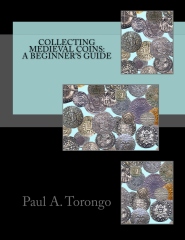 When I self-published my book via Amazon's CreateSpace, among other little problems, I was forced to choose a retail price of $50.00 (Amazon then immediately put the book out there for $15).
When I self-published my book via Amazon's CreateSpace, among other little problems, I was forced to choose a retail price of $50.00 (Amazon then immediately put the book out there for $15).
At the time, I did not choose for CreateSpace's Expanded Distribution program, because it cost $25 (Regular Distribution being free of charge). This meant that my book was only available to buy via Amazon or CreateSpace, and bookstores could not order it.
Now I see that the price for Expanded Distribution has been changed to FREE. So I signed up, and within 6-8 weeks (after the changes take place in the system) my book should be available to order for bookstores, libraries, whoemever.
This is of course good for me (and any other author), but it comes with yet another weird CreateSpace requirement: my book now "retails" for $70.00!! (That is, if anyone were to order it via CreateSpace itself, which no one ever has or will.) I assume I don't need to mention the price increase was again forced upon me by CreateSpace (although I just have mentioned it).
Ah, and what effect will all of this have on the Amazon retail price? (Currently about $26, although it fluctuates with the breeze.)
Have I now lost myself future sales as the Amazon price rises in response to my book no longer being their exclusive territory?
And how much are they going to charge retailers? MORE than the book would have cost on Amazon? Will no retailer ever order it because the book would be ridiculously expensive for customers in their store?
My conscience would not let me ask $70 for my book, especially when I know people have already bought it for $15. So I cancelled my Expanded Distribution, and my book will NOT be available in stores. Oh well!
To read the complete article, see: AN AUTHOR'S EXPERIENCE: CREATESPACE AND AMAZON.COM (www.coinbooks.org/esylum_v16n37a10.html)
THE UNIVERSAL RARITY SCALE

In the early 1990s, I devised the Universal Rarity Scale. As of that time, there were several different rarity scales in use, some mainstream such as the one proposed by Dr. William H. Sheldon in 1949, and others obscure—such as that created by Edgar H. Adams and William H. Woodin to describe patterns. The Fuld books on Civil War tokens had yet another system.
All of these applied to coins, tokens, medals, and currency that ranged from unique to 1,000 or so estimated to exist. For coins of which tens of thousands or millions exist—say Proof coins from 1950 to date, Morgan silver dollars of all dates and mintmarks except 1895 Philadelphia, modern commemoratives, and more, there was no applicable rarity scale.
The Universal Rarity Scale is mathematically sound in its progression and relationship among its divisions and is applicable to any series. Stated simply, it is a geometric progression of numbers, rounded off for convenience in use, with each category containing about twice as many members as the preceding category. The proposed Universal Rarity Scale uses a simple geometric progression of numbers, as 1, 2, 4, 8, 16, 32, etc.
For the numismatist, the Universal Rarity Scale permits accuracy not hitherto known. For example, an 1884 trade dollar (10 known) is URS-5, while an 1885 (5 known) is URS-4. The 1870-S $3 and 1873-CC no-arrows dime, each of which is unique, are each URS-1. The 1873-S Liberty Seated dollar, of which none is known to exist, is URS-0.
The same scale used to evaluate the preceding can also be used to evaluate an issue of which hundreds of thousands of coins are known. Thus, we know that the General Services Administration disposed of 675,000 Mint State 1884-CC dollars in the 1970s, and, in addition, probably a hundred thousand or more Mint State 1884-CC dollars were released before then. Under the Universal Rarity Scale, the Mint State 1884-CC can be described as URS-21 (500,001 to 1,000,000 known). A 1989-S Proof set (of which 3,005,776 were sold) is URS-23.
With the Universal Rarity Scale, collectors of modern Proof sets, silver dollars, Hard Times tokens, large cents, and other series can all talk the same language.
In contrast, using the Sheldon Scale, a Mint State 1879-CC dollar, a “scarce” or “rare” coin to any specialist in the Morgan dollar field, would be listed as R-1, or “common,” as, perhaps, 10,000 Mint State coins are known. Similarly, a Very Fine 1893-S Morgan dollar would be R-1 per Sheldon. In fact, not a single circulation strike Morgan dollar issue would be even R-4 on the Sheldon Scale! Listed as R-1 on the Sheldon scale would be the elusive 1879-CC as well as the very common 1881-S. Under the Universal Rarity Scale, the Mint State 1879-CC would be URS-15, while the common 1881-S would be URS-22. The seldom-seen Proof 1895 would be URS-11. In Mint State, the very rare 1893-S would be URS-6.
By means of the URS notation, anyone wanting to quickly compare rarities of various coins across different series can do so easily.
Should anyone else wish to use it, the Universal Rarity Scale is available without license or credit line. A satisfactory way to use it is as follows: “1885 trade dollar. URS-4.”
To read the complete article, see:
Revisiting the Universal Rarity Scale
(www.stacksbowers.com/NewsMedia/Blogs/TabId/780/ArtMID
/2678/ArticleID/64348/Revisiting-the-Universal-Rarity-Scale.aspx)
THE BOOK BAZARRE
NOTES FROM E-SYLUM READERS: FEBRUARY 16, 2014
Louis Van Belkum The headline of last week's article on author Louis Van Belkum gave his birth year as 1924. Rich Hartzog writes:
My records indicate he was born 10/8/1942.
To read the earlier E-Sylum article, see: LOUIS VAN BELKUM 1942-2013 (www.coinbooks.org/esylum_v17n06a09.html)
Harvey Stack on The E-Sylum Harvey Stack, Senior Consultant at Stack's Bowers writes:
Congratulations on the way you manage, print and circulate The Esylum.
It is without doubt the best publication of its kind, published weekly, and embraces all facets of numismatics in a very scholarly way. E-Sylum provides current news, articles in special series, opinion letters, listings of future auctions, both for coins and the literature available to be aware about, and all done scientifically and accurately like no one has ever done successfully before.
Keep up the good work and you will attract many more readers who want to be informed more about our hobby and the tools we use. Here's wishing you many more years of success and admiration of your fellow collectors.
Kazakhstan Golden Warrior Coin Image Found Adrienne Mayor writes:
 A curator at the American Numismatic Society whose father is in Astana actually sent me a high res image of the coin. I really appreciate you and your fellow collectors' willingness to help.
A curator at the American Numismatic Society whose father is in Astana actually sent me a high res image of the coin. I really appreciate you and your fellow collectors' willingness to help.
To read the earlier E-Sylum article, see: NOTES FROM E-SYLUM READERS: FEBRUARY 9, 2014 : Query: Kazakhstan Golden Warrior Coin Image Sought (www.coinbooks.org/esylum_v17n06a10.html)
The Sticky Sticker Situation Regarding George Kolbe's article about the dust jacket sticker on most copies of Don taxay's Counterfeit, Mis-Struck, and Unofficial U.S. Coins , Fred Michaelson writes:
I can't wait to get that first-edition Taxay book that I won in the Fred Lake auction so I can see the dust jacket.
 Both of my Taxays have the sticker. Fred asked - "Which would be the better one to have---with sticker or without?" I wrote, "A Taxay book without the sticker would be rare, but as George described in his article you can remove the sticker with acetone, so it might be hard to prove there never was a sticker on your copy. As a result I don’t think there will be much of a premium for stickerless copies, but I could be wrong."
-Editor
Both of my Taxays have the sticker. Fred asked - "Which would be the better one to have---with sticker or without?" I wrote, "A Taxay book without the sticker would be rare, but as George described in his article you can remove the sticker with acetone, so it might be hard to prove there never was a sticker on your copy. As a result I don’t think there will be much of a premium for stickerless copies, but I could be wrong."
-Editor
Fred writes:
The graders at BGC with their electron microscopes could probably tell whether a sticker's been removed.
P.S.---BGC is the Bibliographic Guaranty Corp.
I asked George Kolbe about this sticky situation. He writes:
I removed labels from two copies and I compromised the underlying print in both. While a person more skilled might be able to leave the printing unscathed, in both copies the area uncovered was slightly different in color. This may be due to exposure to light or to a chemical reaction, likely both. Removal of the label from a copy kept shielded from light and in a cool environment over the years might be incapable of detection, but I doubt it.
The Taxay article was great fun to write and, even beyond the world of us book weenies, has been enthusiastically received.
To read the earlier E-Sylum article, see: TALE OF THE TAPE: PITTMAN, BREEN AND THE TAXAY BOOK BLURB (www.coinbooks.org/esylum_v17n04a10.html)
American Legion Badges and Medals Reference Book Regarding Harry Waterson's article about the American Legion school medals, John Sallay writes:
 I collect school award medals and have a bunch of these in my collection. I don’t know the sculptor of the 1950 boys’ medal, however, there was a book published in 2004 by a Peter J. Eisert entitled “The National Convention Badges, Membership Badges, & Award Medals of the American Legion” (ISBN 0-9753865-0-6). While the book does not list the sculptor, there is an extensive set of footnotes and this might help with some further research, if Harry hasn’t already seen it.
I collect school award medals and have a bunch of these in my collection. I don’t know the sculptor of the 1950 boys’ medal, however, there was a book published in 2004 by a Peter J. Eisert entitled “The National Convention Badges, Membership Badges, & Award Medals of the American Legion” (ISBN 0-9753865-0-6). While the book does not list the sculptor, there is an extensive set of footnotes and this might help with some further research, if Harry hasn’t already seen it.
Harry Waterson writes:
“I do have a copy of the Eisert Book. But no joy there in trying to mine the bibliography for artist info. I am not a collector of these medals but have an interest in the artist, R Tait McKenzie who I admire a lot. And as I got into the sequence of the medals I got interested in the double standard they exhibited and how they slowly sorted it out.”
John Sallay adds:
The book may still be of interest to a few E-Sylum readers, but I might emphasize that it is primarily a pictorial listing of several types of American Legion medals, while Harry’s article in The Clarion is a much deeper exploration of the evolution of the extensive American Legion school medal series. He and I continued our e-mail exchange and agree, among other things, that the R. Tait McKenzie medals from the 1920’s are a great introduction to these medals since they are both artistically terrific and readily available on eBay at very reasonable prices.
To read the earlier E-Sylum article, see: THE AMERICAN LEGION SCHOOL AWARDS (www.coinbooks.org/esylum_v17n06a26.html)
William Sheldon on NC Cents James Higby writes:
It is my conviction that the greater enemy of historical accuracy is not in the forgetting of things that happened, but in the remembering of things that never happened. Thanks, therefore, to John Kleeberg for pointing out my error in a recent post regarding the NC designation.
Such an event, though, forces me into primary documents for both confirmation and clarification. Here is what Sheldon wrote on page 53 of Early American Cents:
"Of the Early Cents 327 true varieties or obverse-reverse combinations are known and are here described. However, not all of the 327 are collectible. Seventeen of them are known by only a single example and in all but four instances these unique coins are now in the museum of the American Numismatic Society in New York. About a dozen varieties are known by only two specimens, one or both of which may have been permanently retired from numismatic circulation. In at least two instances three examples of a variety are known but not more than one of these is "out" and in the hands of collectors...By and large...the NC's [sic] remain unobtainable and the collector will in the long run be happier to leave them off his want list."
To read the earlier E-Sylum article, see: JOHN KLEEBERG ON THE NON-COLLECTIBLE DESIGNATION (www.coinbooks.org/esylum_v17n06a18.html)
Photo Of Yale Specimen of Wass, Molitor $20 Sought Dave Stone (U.S. Coins cataloguer at Heritage Auctions) writes:
I have a question for E-Sylum readers. Does anyone have a good image of the Yale University specimen of the Wass, Molitor & Co. Large Head $20? I believe it was from the Dr. George Alfred Lawrence Collection (Thomas Elder, 6/1929), lot 1406, but I don’t think it was plated in the catalog. Thanks for any help you can give me.
Kaiser Wilhelm I (1861-88)
Last week in his submission about a supposed hidden image of the Emperor of Germany on the 1881 Swiss 20 Centime coin, Bob Fritsch writes:
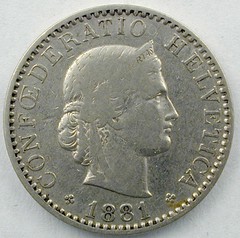
The German Kaiser in question would have been Frederick III, who ruled until 1888.
Martin Purdy writes:
Martin forwarded this link to Wikipedia for further information: William I, German Emperor (en.wikipedia.org/wiki/William_I,_German_Emperor)
To read the earlier E-Sylum article, see: QUERY: IMAGE OF 1881 SWISS 20 CENTIME SOUGHT (www.coinbooks.org/esylum_v17n06a19.html)
ST. LOUIS BUSINESS JOURNAL INTERVIEW ERIC NEWMAN
 Spend a morning with Eric Newman, age 102, and be prepared to be blown away.
Spend a morning with Eric Newman, age 102, and be prepared to be blown away.
He’s been a lawyer, a businessman, an inventor, an author, a world traveler, a philanthropist and an internationally renowned numismatist who recently sold 1,800 rare American coins for $23 million. He paid about $7,500 for them, and he has several hundred thousand other coins and pieces of paper money left in his collection and at the Newman Money Museum at Washington University.
He and Evelyn, his wife of almost 75 years, went on an eventful honeymoon in 1940. It was at the start of World War II, but before the U.S. got involved. We didn’t have room for the story in our print edition Q&A with Newman, so here it is, in his words:
“We took a seven-week cruise on the S.S. Argentina to Buenos Aires and back in 1940 after our marriage in 1939, at a time when German pocket battle ships had been sinking British merchant ships.
“When we were on the cruise ship between San Paolo, Brazil, and Montevideo, the ship next to us at the harbor was a British decoy ship. A German ship, the Graf Spee, went after the decoy, and the battle began. We sat on the top of the mountain of Montevideo and took moving pictures of the Graf Spee, which was scuttled by its captain.
“We sent a telegram to our family, and the news spread all over St. Louis. When we got back to St. Louis there were several hundred people waiting to see us — our family, of course, but the others came to see the pictures of the scuttling.”
To read the complete articles (subscription required), see:
St. Louis Character: Eric P. Newman, a century of collected memories
(www.bizjournals.com/stlouis/print-edition/2014/02/14/
st-louis-character-eric-p-newman-a.html?page=all)
It's not just coins: another story from Eric Newman
(www.bizjournals.com/stlouis/blog/2014/02/
its-not-just-coins-another-story.html)
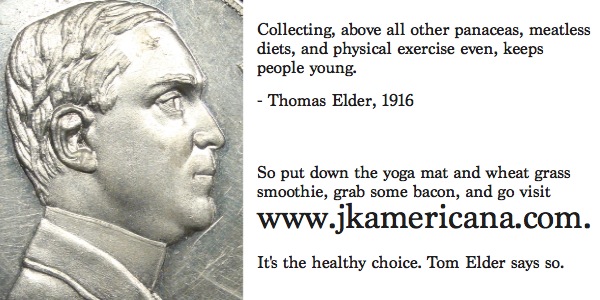
MEL WACKS' TURKEY COUNTERSTAMP
In his Numismatic News article, Clifford Mishler wrote this about a coin he'd found with a counterstamp of a Turkey:"I suppose I will never know the who, why or how many were similarly counterstamped."
Jonathan Brecher writes:
Ah, a challenge like that is a red cape waved in front of an E-Sylum reader! That is a Mel Wacks product.
 "Considering the success of my first counterstamped coin, just a few months later I created another one. This was issued on Thanksgiving and appropriately honored the turkey. The coin chosen was the 1961 Proof Benjamin Franklin Silver Half Dollar. Why?
Because Franklin had proposed that the national bird should be the turkey (the bald eagle won out). A turkey was counterstamped over the Liberty Bell (just to the left of the "winning"
eagle).
"Considering the success of my first counterstamped coin, just a few months later I created another one. This was issued on Thanksgiving and appropriately honored the turkey. The coin chosen was the 1961 Proof Benjamin Franklin Silver Half Dollar. Why?
Because Franklin had proposed that the national bird should be the turkey (the bald eagle won out). A turkey was counterstamped over the Liberty Bell (just to the left of the "winning"
eagle).
A full color reproduction of John James Audubon's engraving (1830) of a wild turkey is featured on the envelope, along with the following quote: "The turkey is a bird of courage and would not hesitate to attack a grenadier of the British guards who would presume to invade his farmland with a red coat on," with the facsimile signature Benj. Franklin. The postage used was the 3¢ Wild Turkey Wildlife Conservation stamp and the 13¢ Bicentennial 1776-1976 stamp featuring a bust of Franklin. And, appropriately, the cancellation reads "TURKEY, TX 79261 NOV 25 PM 1976." The back of each envelope was printed with a serial number, and "LIMITED EDITION of 500." My records indicate a mintage of 200. "
Jeff Kelley writes:
His subsequent issues honoring various events and milestones were done using dies which produced devices in relief against a flat background, but this one was a more traditional incused style counterstamp.
To read the complete article, see:
The Counterstamped Coins of Mel Wacks
(www.tokenandmedal.org/Journal/Journal_files
/Counterstamped_Coins_of_Mel_Wacks.pdf)
To read the earlier E-Sylum article, see: TURKEY COUNTERSTAMP ON A FRANKLIN HALF DOLLAR (www.coinbooks.org/esylum_v17n06a27.html)
2014 MEDAL COLLECTORS OF AMERICA MEDAL

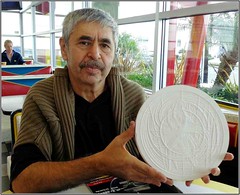 The Medal Collectors of America are pleased to announce the issuing of their club medal for 2014. Designed and hand finished by well-known sculptor/engraver Alex Shagin. The medals contain nearly five ounces of metal and will be issued in silver and copper, for $250 and $40 respectively, including postage. The estimated maximum mintages will be 25 in silver and 50 in copper. There is a limited quantity remaining. Orders for silver must be received no later than April 15, 2014. Collectors interested in purchasing medals can send payment to:
The Medal Collectors of America are pleased to announce the issuing of their club medal for 2014. Designed and hand finished by well-known sculptor/engraver Alex Shagin. The medals contain nearly five ounces of metal and will be issued in silver and copper, for $250 and $40 respectively, including postage. The estimated maximum mintages will be 25 in silver and 50 in copper. There is a limited quantity remaining. Orders for silver must be received no later than April 15, 2014. Collectors interested in purchasing medals can send payment to:
Medal Collectors of America
C/O Ron Thompson
1471 Leaf View Road
Decatur, GA 30033
The medal, designed by Alex Shagin and Gerry Muhl is described as follows:
Obverse:
It shows a freedom of Spirit and liberty without which art will not develop. There is a flow of life letting creativity develop to the fullest.
The medal speaks of working together in the game of life to build on what came before in a spirit of joy – not being tied down to just one idea.
Reverse:
The medal is playful in that you have to hold it and look at it from many angles. You have to turn it to examine and read it – especially the ribbon in the back with the name of the club. Are you in the Game?
For more information on Alex Shagin, see: Alex Shagin (en.wikipedia.org/wiki/Alex_Shagin)

Archives International Auctions, Part XVII
Rare U.S. & Worldwide Banknotes, Scripophily, Security Printing Ephemera, Further Selections From the Hamtramck Collection & Part 1 of the Scarsdale Collection of Modern African Banknotes
Highlights include:
- Lot 102 Banco de Quito. 5 Pesos. 1880. Pick #S242 Unlisted as issued note
- Lot 704 Essay Proof of Merchants National Bank of Chicago - a rare essay proof of original issue national banknote
- Lot 394 Central African Republic, 5000 Francs, P-11
- Lot 837 Crescent Mutual Insurance Co., ca.1850's Specimen Stock Certificate
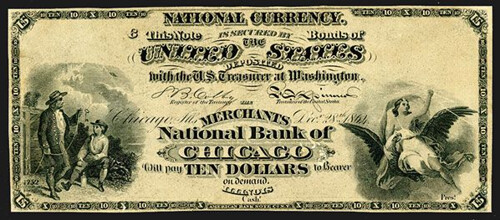
1580 Lemoine Avenue, Suite #7
Fort Lee, NJ 07024
Phone: 201-944-4800
Email: info@archivesinternational.com
WWW.ARCHIVESINTERNATIONAL.COM
MORE ON RUTH HILL
Howard Daniel writes:
I went to the Heritage website and looked at the Ruth Hill lots. I found several old French Indochina notes that are illustrated in my old first and second editions of my catalogs for them which I did not remember the sources. Now I have added Ruth Hill to them in my database so she is recognized in the third edition. I know there must be more notes so I will keep my eyes open for them.
Back in the late 1970s and into the 1980s she kept sending me an updated book want list. Some of the items were "any book" on a particular subject! I must have found about twenty-five books for her over those years, and she was elated to receive each one of them. I am not sure I remember what happened to her library, but I know it was a treasure trove for numismatists!
Ruth was a great old lady and I loved to be in her company. She was a big supporter of the International Bank Note Society and when she passed, most of the members were heartbroken.....I know I was!
Howard sent the following from the IBNS web site, which does refer to her as a founding member:
Ruth Hill, or Mrs. Adolf B. Hill Jr. III as she liked her letters to be addressed, was the grand old lady of paper money collecting in North America.
Born in 1898, she remained an active collector all her life and a visitor to shows until a few years before her death at the age of 96. Ruth Hill became interested in banknote collecting in the 1950s, about the time of the death of her husband whose company sold specialty inks. Over more than 30 years she built a vast collection of notes from almost every country of the world and, at the same time, encouraged numerous new collectors.
She was a founding member of IBNS and in 1966 she rescued the young society from collapse when it ran into severe financial difficulties and its survival was in doubt. She was later a board member and then president from 1979-81. Ruth Hill was appointed an Honorary Life Member and an honorary director for life in recognition of her long and vital support for the IBNS as an institution.
To read the complete article, see: Ruth Hill (2010) (www.theibns.org/joomla/index.php?option=com_content&view=article&id=259:ruth-hill&catid=30:hall-of-fame&Itemid=177)
Ruth Hill was a native of Texas. She also lived in Georgia and Florida before setting to St. Louis. Ruth ... became interested in collecting bank notes in the 1950s, about the time of her husband's death. Her husband, Adolph, was a representative for a company that sold ink made to specification. It was through his dealings with the Banco de Mexico that she caught the bank note collecting virus. When she attended her first coin show, she often said, she felt out of place as one of the few women there. She also said it was necessary to ask for bank notes, since most dealers did not bother displaying the few pieces they might have. With few exceptions Ruth Hill collected bank notes from every country.
Finally, Howard adds:
I first met her when I attended my first ANA Convention, which was in St. Louis, and think was in 1976. She quickly latched onto me and we were friends for the rest of her life. I only saw her once or twice more, but we often corresponded by letter (remember those?) and we helped each other with our wants for notes and books. She was one of my early mentors in numismatics.
To read the earlier E-Sylum articles, see:
QUERY: WHERE IS THE RUTH HILL WORLD PAPER MONEY COLLECTION?
(www.coinbooks.org/esylum_v16n07a16.html)
MORE ON THE RUTH HILL WORLD BANKNOTE COLLECTION
(www.coinbooks.org/esylum_v16n08a07.html)
HERITAGE TO SELL RUTH HILL BANKNOTES
(www.coinbooks.org/esylum_v17n06a28.html)
A DEFENSE OF BRAD TROEMEL'S EBAY ART PROJECT
Last week, I republished comments from artist Brad Troemel taken from an online exhibit of his work, which included this description of how he'd altered copies of colonial coins:
When I made counterfeits to be sold on eBay I would try to blend in too, to be real. I would purchase educational counterfeits of colonial coins that were independently made in the 1780’s... The first task would be to go to my driveway and use a brick to wear the coin down far enough so that the stamped COPY indentation was no longer visible.
... At the end of the eBay description I would assure my faked obliviousness as a seller by professing to know nothing about coin history and restate that the coins were for sale “as is” because of my lack of knowledge. This would keep the door open for the hopeful who thought there was an outside chance of me being a rube and the coins being real...
While I felt Troemel's work overall was "legitimate and fully within the theme of modern money artists," I had trouble with his removal of the word "COPY", which is illegal to do to copies offered for resale (at least, that's my understanding of the Hobby Protection Act). I wrote:
"Faked obliviousness"??? Tell it to the magistrate - that's the biggest load of rubbish I've ever heard in my life. You're saying you're not really an eBay scammer because you were only PRETENDING to be an eBay scammer??? If you look like a crook, act like a crook, and take people's money like a crook, well, maybe you could put on a play for your fellow inmates at the prison Christmas pageant.
Taking money like a crook...? I'm not sure about the implications of ethics and criminality here. Would you blame a collector for showing some pride in a coin that he or she purchased at a bargain price from a seller who had less idea of its actual market worth? Profiting from this kind of exchange is surely one of the celebrated pleasures of collecting. The question of propriety doesn't enter into this equation: after all, isn't this an accepted part of dealing in a free-market?
If one reverses the respective advantages enjoyed by buyer and seller in the scenario above, then you have the basis of Brad Troemel's eBay project which I see as operating squarely (if somewhat cynically) within the commercial realm of collecting. Whether or not it is appropriate to label either case as 'dishonest' depends on how technical you want to get about the rights and obligations attached to appraisal (how many collectors would admit their knowledge to the seller and then offer something comparable to its market value?)
Troemel's efforts at defacement don't seem to me to have anything to do with the practice of collecting for the love of the object. I could be wrong but I doubt that these "barely legible" coins would have attracted the interest of serious collectors. Their appeal was rather to those who imagined they could turn a profit on someone else's guilelessness. Having been on the receiving end, I take no joy in the idea of an individual being cheated, however I can appreciate a sort of comedy in someone being tempted into spending money to purchase money while gambling on the chance that they'll make even more money from the exchange.
And remember that we're not talking about the sort of money people would pay if they were under the false impression they'd be getting a specific coin. Troemel's work was nothing like eBay fraudulence in the way that might rightly offend many of your readers. He didn't deceive by pretending to offer something particular - he did the opposite. By erasing the features of the coins, he created an empty space - a 'blank' - which was filled by the speculative imaginings of buyers. The artist himself has described how he fuelled these imaginings with a story about a mobster's counterfeiting operation: "My collectors were buying into a story and were receiving coins in exchange."
My feeling is that if you accept the work of any artist as legitimate, then you've committed yourself to giving serious (and critical) consideration to a lifetime of research. This might be difficult when the artist is young, hip and unashamedly provocative. Flashes of irreverent brilliance are the prerogative of artists in their youth and result in things that are often only appreciated after maturity puts a check on reckless experimentation. Troemel may be a challenge, but it would be wise not to dismiss the work as a criminal act and thus take the part of a fusty custodian against the delinquent.
There are, as you observe, other legitimate artists like J.S.G. Boggs whose fascination with money's reproduction brings them close to the edge of legality. In fact what makes their work so interesting is the fact they deal with the monetary object as an visual embodiment of legal obligations and prohibitions that is ambiguously the property of both the individual and of the State. The inevitable consequence is that the individual artist risks prosecution by working with something whose reproduction is protected by law.
Artists such as the post-war Japanese Genpei Akasegawa or the American tromp l'oeil painter, Otis Kaye, maintained an allegiance to their subject of their research even when the full and oppressive weight of the law was brought against them. For Otis Kaye, this meant he was not allowed to sell a single painting during his lifetime, although posthumously his work became part of the art collection of the Federal Reserve!
The work of J.S.G. Boggs (who, incidentally, had quite a lot to tell magistrates throughout his career) is relatively less troublesome than Troemel's because it has a more palatable relationship to the way art functions in the marketplace. It generates capital on the basis of what he (re)produces as original drawings: a handiwork we tend naturally to associate with fine art's more genteel traditions.
Brad Troemel, on the other hand, applied a different method of reproduction - one that makes his work no less 'art'. He used the age-old counterfeiter's technique of alteration but instead of 'raising' a token's nominal value, he generated capital by blurring it. The action is doubly irreverent and disrespectful because at the same time as defacing money, his amateur chemistry produced its imitation (two technical illegalities). He erased signs that identified the coin as an "authorised" reproduction and thus created a mischievous confusion. Of course he knew that much of how we value money (as currency and as artefact) depends on maintaining a clear distinction between the original and the copy - even though, as he observes in his essay, the free market already complicates this distinction by prizing counterfeits themselves as 'original' objects. (Note that his 'mobster' coins are already pretending to be counterfeits).
What I've described above might simply represent different approaches of artists to the same general topic: the mystery of how money conjures value from appearances. Given that art is a profession that has traditionally created wealth from artifice and reproduction it's not surprising that some artists exercise a reckless fascination with process of printed money's self-certification. Such a recklessness in Troemel's approach (at least in the case of his eBay project) might understandably make a numismatic collector uncomfortable, but even if you find its methodology questionable, please don't mistake his work - as ostentatious, conspicuous and temporal as it is - with commercial scams that are banal, anonymous and persistent.
To read the earlier E-Sylum article, see: MONEY ARTIST BRAD TROEMEL EXHIBITION (www.coinbooks.org/esylum_v17n06a29.html)
THE BOOK BAZARRE
WAYNE'S NUMISMATIC DIARY: FEBRUARY 16, 2014
Most of my numismatic pursuits recently involved working on The E-Sylum. But I had a pleasant interlude on Monday when I met author Roger Burdette on my way home from work. I had a book in my library he wanted to borrow for his latest research, so we agreed to meet. We picked J. Gilbert's, a restaurant in McLean, Virginia where we’d had Nummis Nova dinners in the past. Nummis Nova is the numismatic social group I started in Virginia. Roger wouldn't be able to make the regular dinner meeting, so I was glad to have the opportunity to chat with him for a bit.
It felt like a clandestine meeting of spies, at a prearranged parking lot. I handed over the book in a plastic bag, and Roger gave me a manila envelope containing a review copy of the Winter 2014 issue of his Journal of Numismatic Research. I suggested stepping into the restaurant for a drink, since by then I needed to use the rest room. Might as well spend some money if I'm going to use the facilities.
Roger's a constant joker, and made a remark about my employer "still having the pay toilets". But he agreed and we had a nice conversation at the crowded bar. Topics included a web site project of mine, and Roger's latest research work.
It was a short get-together, but I had to get home, and Roger wanted to get busy copying the material he needed from my book. But I had a more substantial event the next night (Tuesday, February 11) when Nummis Nova met for dinner at The Esposito's Italian restaurant in Fairfax, VA.
Ron Abler and Chris Neuzil couldn't make it either, but we otherwise had a pretty full house. I was among the last to arrive. Already there were Steve Bishop, Tom Kays, Gene Brandenburg, Dave Schenkman, Mike Packard, Aaron Packard (no relation), Jon Radel, Eric Schena, Wayne Herndon and Joe Levine. Julian Leidman was the last to arrive and he took a seat next to Joe.
I brought a copy of David Lange's new book on National Coin Albums. It's such a quality production I like to show it to people in person. I also wanted to show Wayne Herndon the photo of Raffi Bulanikian, Manager of M. Meghrig and Sons. I also brought my numismatic postcards and stereo views to show Tom.

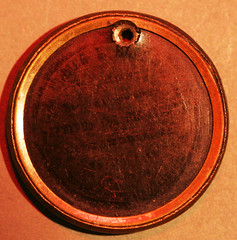
As always, some interesting and rare numismatic material was passed around the table. Dave Schenkman had a neat ferrotype of the first casualty of the U.S. Civil War, Col. Ellsworth. Dave writes:
It is a really neat item. I received it a few days ago as part of a consignment. I’ve seen Ellsworth ferrotypes with a portrait of Brownell on the reverse but never one like this. At first glance the reverse is blank, but when I examined it today noticed a printed legend which reads COL. ELMER E. ELLSWORTH / THE GALLANT / ZOUAVE COMMANDER. / MARTYRED FOR HIS COUNTRY / ALEXANDRIA, VA. / MAY 24, 1861. There are two more lines but I can’t read them.
Dave also passed around a Comfort Bus Line token. He writes:
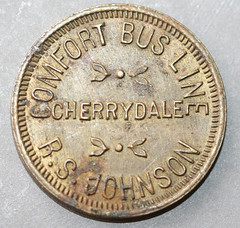 In the Virginia catalog I commented that “This line operated in the Cherrydale section of Arlington from about 1921 to 1926. There were three jitney-like buses, similar to Model-T Fords, with long bodies and fragile sides.” The token is brass, 24mm, and the reverse is the same as obverse. Interestingly, the die exists for a larger but similar token, but no actual tokens have ever surfaced. I acquired the token in my collection in the 1960s, and this is the only other one I’ve ever seen.
In the Virginia catalog I commented that “This line operated in the Cherrydale section of Arlington from about 1921 to 1926. There were three jitney-like buses, similar to Model-T Fords, with long bodies and fragile sides.” The token is brass, 24mm, and the reverse is the same as obverse. Interestingly, the die exists for a larger but similar token, but no actual tokens have ever surfaced. I acquired the token in my collection in the 1960s, and this is the only other one I’ve ever seen.
TOM KAYS' NUMISMATIC DIARY: FEBRUARY 16, 2014
As Wayne (our superb E-Sylum Editor) enjoyed a fine Italian repast at the far end of the table at “The Espositos” Restaurant in Fairfax, Tom Kays acting as secondary club secretary, captured some of the fast paced action and show and tells passing down at his end of the table, in order to share a little flavor of what transpires at a typical Nummis Nova dinner with the E-Sylum readers unable to join us in person.
I invite you to consider joining us as a visitor, for a memorable evening of coin talk in Northern Virginia. If you can keep up with our rowdy crowd, have unique experience in some facet of numismatics, and are quick in wit (and picking up checks) at the dinner table, full of numismatic wisdom, and flush with odd money to show-and-tell us about, contact Wayne, who would be glad to provide tickets to qualified individuals, by special invitation.
For example a Director of the U.S. Mint once joined us as a distinguished visitor, and now he is out of that job. See what associating with us might do for you! On the erudite side of the table sat Steve Bishop [just to the left, out of frame], Dave Schenkman, Wayne Herndon, Eric Schena, Aaron Packard, and Joe Levine. On my side supped, myself, Gene Brandenburg, Jon Radel, Mike Packard, Julian Leidman and Wayne Homren, all regulars at these events.

Show and Tell at my end of the table began before the antipasto, centering on uncirculated examples of raw and slabbed, Morgan dollars, some with nice bulls eye, rainbow toning, and to be precise, by “nice Morgan dollars” for example I mean I saw an 1882 CC VAM-2a (Hit List 40) GSA Hoard, NGC, MS-64 along with a blur of good dates including 1879 CC, 1889 CC and 1895 O examples. I’m not sure Wayne got to see them as they were a couple of discussions away down the table from him, on the far side of the boisterous contingent from Southern Maryland (who were delighted with pizza as an appetizer).
Floating along the checkered tablecloth, among the menus, were a “Vampire” Francais of Napoleon III le Miserable, in commemoration of awful events in the Sedan, in 1850 – 1851, a spate of gold coins including a Pistole of 1788, a Louis d’Or of 1726, an 1891 CC Eagle. A Monogram, Medio of Mexico of Charles and Johanna (the Mad) circa 1542-1553, that Gene had never seen before, a pair of Ecus of Louis XIV and XV, a MEPCOM Coin of Merit (Military Challenge Coin in the shape of the Pentagon) and a fine Civil War dog tag inscribed for CORP. J. MC.INTIRE – Co. D. – 2d DEL. V. with battle honors MALV HILL, ANTIETAM, FRED’KSBRG, GAINES MILL on a Major General George B. McClellan, War of 1861 obverse.
 Each passed in review, sometimes in a jumble, each with a fascinating story being told in unison at times. With a serving of bread baskets, came a beautiful silver, Republique Francaise, Paris 1900, Exposition Universelle, 4me Match International Fusil, Olympic plaquette, and a set of 19th century Argentine medals from Buenos Ayres with their extremely rare original proclamation velum, and the famous Byron S. Loutzenhiser – Republican Candidate for County Coroner Token of May 17, 1910 with McKinley Memorial Dedication reverse, which continued round about the salad course. Are you keeping up? Did you catch all the interesting stories about them? Try more Merlot.
Each passed in review, sometimes in a jumble, each with a fascinating story being told in unison at times. With a serving of bread baskets, came a beautiful silver, Republique Francaise, Paris 1900, Exposition Universelle, 4me Match International Fusil, Olympic plaquette, and a set of 19th century Argentine medals from Buenos Ayres with their extremely rare original proclamation velum, and the famous Byron S. Loutzenhiser – Republican Candidate for County Coroner Token of May 17, 1910 with McKinley Memorial Dedication reverse, which continued round about the salad course. Are you keeping up? Did you catch all the interesting stories about them? Try more Merlot.
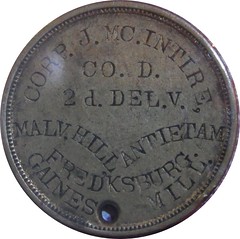
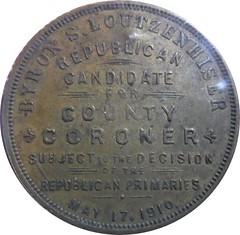
After salad, a flotilla of about fifty Civil War tokens steamed up stream, at one point occupying defensive positions amongst the wine bottles, as they went into action, and were captured by my side of the table with no parole. Of special acclaim, and not for sale, I saw a Charleston SC, M-SC-2 of Bernard S. Baruc, Importer of Fancy Goods in AU-55 (ex John J. Ford, Jr.), several New York tokens including one from the Felix Dining Saloon, New York, NY F-630W-2b in MS-62 from the Louis Kaufman Collection and a Detroit MI F225AJ-3a in MS64 from Hanna & Co. Tobacconists.
I leave one last example to your imagination as I saw a New York, NY F630 AGA-1h token in AU-55, and of course you know who issued it and what patriotic image it sports, since you are a virtual, qualified guest.
The main course arrived after the tokens marched away in captivity, my entre being a delightful Feste de Mare. Keeping high above the marinara, clam shells and olive oil, passed numismatic books and ephemera including a copy of From Crime to Punishment - Counterfeit and Debased Currencies in Colonial and Pre-Federal America by Dr. Philip L. Mossman (Numismatic Studies 27 by the ANS) and Coins for Colonial Virginia by Eric P. Newman, 1956.
Yet the highlight of the dinner for me was the dessert (Tartuffe to die for) and Wayne’s collection of antique stereo and postal cards of mints, numismatic, and money themes. Here we travel back in time to view the Bureau of Engraving and Printing (circa 1904) to examine uncut sheets of saddle blankets for errors.
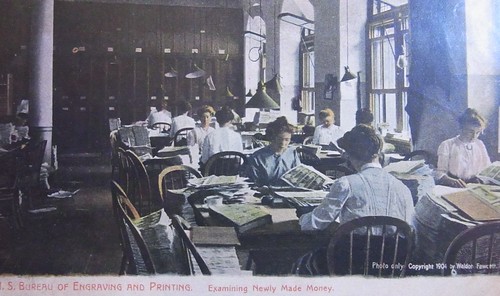
Note the two foot high stack of uncut notes casually sitting on the seat of the chair on the left. Now we help count the stacks of bills and notes and wonder how many end up in those fancy metal trash cans.

So, are you salivating over spending an evening in this manner? Are you geographically compatible with NO VA (Northern Virginia)? Are you able to convivially converse about coins, eat with decorum (or at least gusto), and leave no fingerprints on the raw, the rare and the reader’s choice of numismatic literature being bandied about the bistro? If so, then you just might be Nummis Nova visitor material. Talk to Wayne about sponsorship. Buon appetito!
I visited Tom's end of the table at the close of the evening to chat with Gene Brandenburg, who kindly offered me a half full bottle of Merlot left over from the night's festivities. Clearly I had been sitting at the wrong end of the table or the bottle would have been emptied long before. As I write this it's Thursday evening and I'm sipping a glass of Gene's Merlot, which is a great way to end a day of shoveling a foot-plus of snow off our driveway and sidewalks. My wife and sons all pitched in, so I'm less sore than I would be otherwise. Spring will be quite welcome once it arrives in these parts. -Editor
COIN CATALOGUERS AND COMPANY STYLE SHEETS
Yes indeed, please keep running the ad. It has everything to do with the tremendous collections we have been lucky enough to have consigned to us recently. I receive one or two responses each week, although I don’t always know whether it’s from The E-Sylum or our website.
Searching for catalogers is an interesting process. Sometimes it just seems so random. For years I’ve operated under the assumption that there were just two elements needed to make a good cataloger: broad-based knowledge of U.S. coins and the ability to write. What I have recently realized is a third component is necessary: trainability. A cataloger cannot be so entrenched in writing one way that he or she cannot easily adapt to the company Style Sheet. And as I have emphasized to all applicants, the importance of the Style Sheet is not a control mechanism on my part; rather, conformity to it gives the appearance that the catalog was written by one person. Plus, we don’t want goofy things slipping into print, like one cataloger capitalizing Quarter and everyone else writing it as quarter. Neither is right or wrong, it’s just that the lower-case spelling has been adapted as our company’s style. This naturally slows down the new cataloger, but speed increases as the Style Sheet becomes second nature.
It’s a slow process. So far I have been able to hire one new cataloger, John Sculley. John looks like he has the makings of a fine cataloger, and his speed has increased dramatically over the past two months. Next Monday, we have a new prospective cataloger beginning who shows promise. He was an applicant who really underscored the importance of trainability. He is 22 years old, not employed in numismatics, lives in a rural area with no internet access, was home-schooled, and has not attended college. But he knows coins, writes very well, and after reading the Style Sheet, he was able to describe several test coins well enough that I thought he was definitely trainable.
HOWARD GIBBS INFORMATION SOUGHT
Web site visitor (and new subscriber) Lisa J. McLaughlin writes:
Saw some old posts regarding Howard Gibbs. He was my grandfather. He was very colorful and had an interesting life. I have some fond memories of him and have been trying to collect information about him for my children and my siblings.
My mother was his daughter from his second marriage. I am living in his original house in which he built a "vault room" to house his coin collection. I am interested in any information or photos you or your readers might have in their archives.
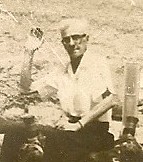 I never met Howard, but belonged to many of the same clubs in Pittsburgh. The Western Pennsylvania Numismatic Society and The Sphinx Society are still ongoing.
Gibbs died in 1970.
His collection was sold in a series of auction sales by Hans Schulman.
I never met Howard, but belonged to many of the same clubs in Pittsburgh. The Western Pennsylvania Numismatic Society and The Sphinx Society are still ongoing.
Gibbs died in 1970.
His collection was sold in a series of auction sales by Hans Schulman.
Gibbs published articles as well as books, and I referred Lisa to the ANA and ANS libraries. I have a couple letters of his from 1947, but they’re fairly routine. I may also have a longer letter elsewhere in my files but can’t put my finger on it right now. He wrote about how he assembled his collection – he was hoping to sell it intact to a museum, but that didn’t pan out. Lisa has a few of the Gibbs books and articles.
Some of our readers are old-timers who may have met him, or heard stories about him from others. Please share some of those with us for publication in future issues. -Editor
To read some earlier E-Sylum articles on Gibbs, see:
HOW HOWARD GIBBS BEGAN COLLECTING
(www.coinbooks.org/esylum_v08n39a25.html)
QUIZ ANSWER: WHO IS THE MYSTERY NUMISMATIST?
(www.coinbooks.org/esylum_v13n19a07.html)
MORE ON HOWARD GIBBS, "THE DUDE ON THE CAMEL"
(www.coinbooks.org/esylum_v13n20a20.html)
MORE ON HOWARD D. GIBBS
(www.coinbooks.org/esylum_v13n22a18.html)

THE 2014 TRIAL OF THE PYX
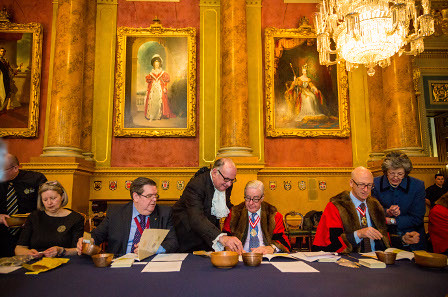
What on earth is a pyx? and why is it on trial?
It’s actually an historic event dating from 1282 and it is, indeed, a judicial trial as most of us would recognise, complete with judge, jury and verdict. I think it’s now time, after more than 700 years of its history, that we put it under the spotlight and shed some light on its history and proceedings.
The word ‘pyx’ is of Latin/Greek origin and simply means ‘box’. The pyx that goes on trial holds a collection of random UK coins from the year’s production to be presented to the jury. At Westminster Abbey there is ‘The Pyx Chamber’ where historically the trial pyxides would be stored. These days, there are, in fact, many boxes involved in the event and they are stored securely at The Royal Mint.
Samples of newly minted UK coins are randomly selected throughout each year during the production process.
They are placed in packets for onward transportation to their trial, where they are inspected to ensure they conform to the standards required by UK law such as weight, composition and size. The number of coins on trial varies each year, but around 40,000 coins will be inspected in February 2014.
The trial has taken place every February since 1282, making this year’s the 732nd trial. It is one of the longest established judicial procedures in the country, and the procedures have changed little over the years, so this year’s trial should run like clockwork! Even a bomb falling nearby in 1940 didn’t stop it going ahead. It is almost certainly the oldest form of quality control and independent quality assessment in the UK, and probably the only trial of its kind in the world.
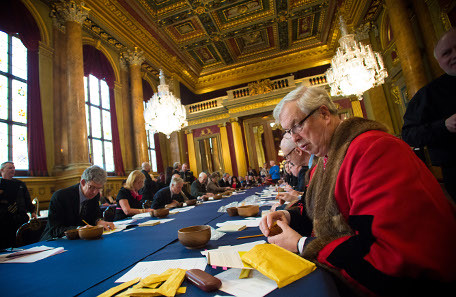
The trial takes place at Goldsmiths’ Hall which, as made official by the Coinage Act 1870, is its established venue.
As a legally constituted trial it is presided over by a high court judge, who holds the title of ‘The Queen’s Remembrancer’ for this process. On trial are the contents of the pyxides as well as the Deputy Master of the Mint.
To read the complete article, see: Trial of the Pyx: Putting the Pyx on trial (www.coinsweekly.com/en/News/4?&id=2590)
SOME NEW COIN DESIGNS: FEBRUARY 16, 2014
2013 Israel Jordan River coin
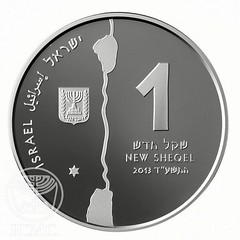

I assume the vertical element on the obverse is a map of the river. I'm on the fence about this one, but I think it works. The reverse scene is nicely balanced.
2014 Belgium Coin Design
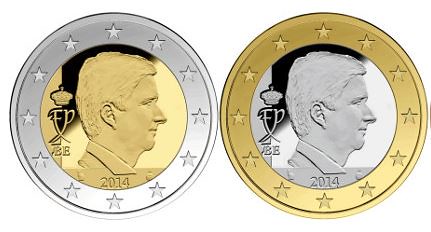
I like the switcheroo of the two metals in this bimetallic design. Are these the same or different denominations? Despite the clear difference, these could get confusing if they're not the same denomination.
2014 Finland 5 Euros
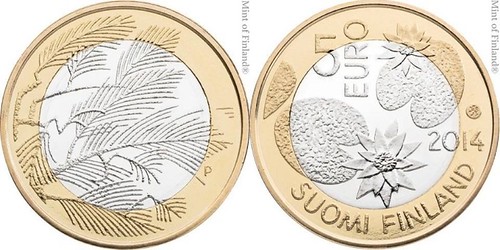
I don't like this bimetallic design as well - I think these work better when the designer incorporates the bimetallic nature of the coin planchet.
2014 France D-Day Coin Design

This one does account for the bimetallic planchet, but the central design is so busy and squeezed that I don't think this one works at all.
2014 Vatican 2 Euro Coin Design
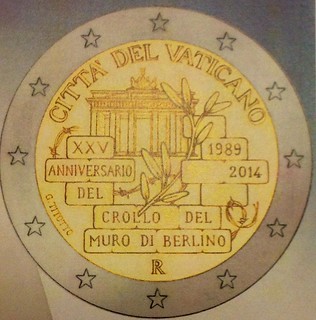
I don't ordinarily like "wordy" coins, but I think incorporating the words as carved into building stones works in this case. It has a classical feel, and I like it.
2014 France European Space Agency Coin Design
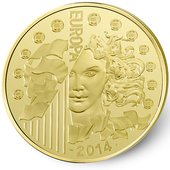
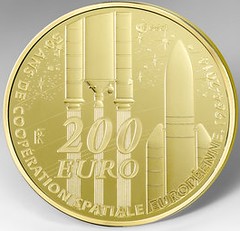
I'm indifferent to the dated side (which they call the reverse). It's interesting and even attractive, but too busy and crowded. I like how they've implied the motion of the rocket at takeoff on the denomination side, incorporating the "200: into the engine propulsion streams. Nicely balanced.
For more information, see:
COMMEMORATIVE COINS TO MARK 50 YEARS OF EUROPEAN SPACE COOPERATION
(www.esa.int/About_Us/Welcome_to_ESA/ESA_history/
Commemorative_coins_to_mark_50_years_of_
European_space_cooperation)
CHOPMARKS ON MODERN U.S. PAPER MONEY
I got a few US $100 notes from a guy from Philippines. I noticed they had been counter-stamped with various logos, probably of banks which authenticated the notes. These logos are just like the old chop mark silver coins. I have never seen them in USA, but then the US $100 hardly circulates in USA, and this must be a far East phenomena..
What is the Numismatic term for them. . . ? I could not find a write up about them on the Internet.
I was told by a currency dealer that with the mark, that agency will accept back the note if found to be a forgery. But then the mark also may get forged to make them more acceptable.
Kavan also contacted Joe Boling, who writes:
I call these chopmarks, as do most other paper collectors. I have them from both the far east and mideast (Arabic script chops). They are used so that a moneychanger does not have to study a note closely, if it already has his chop showing that he did that before. Sure, they could be forged, but the original user would be quite likely to detect that easily - it's not likely to be a perfect match for the stamp he has on his desk. As far as I know, nobody has studied these, and certainly no guide exists linking each chop to its originating source. A friend here in Indianapolis is trying to build an exhibit of these for US competition at coin shows. I don't know how many he has collected, nor what approach to describing them he plans to take.
Have you ever had a $50 or $100 bill and wondered where it has been? Have you ever noticed little stamps or markings on the backs of these bills? These are chop marks. Chop marks were made famous by US trade dollars. They were used earlier on Spanish milled dollars that went overseas. They were used to mark a coin as yours because either a bank does not exist near you or because the banks that are near you don't take that particular currency or coin. If you mark a coin and someone steals it you are able to identify it. This tradition continues today in cities in the Middle East and Asia. I am going to start to document these marks as I find them on modern American currency. The US dollar is the most traded currency in the world. I will use this thread to post pictures of the stamps I find. If you find any please feel free to post an image.
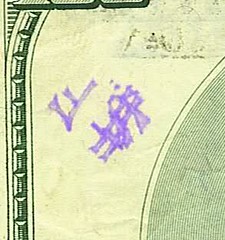
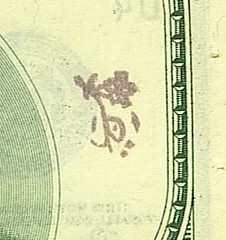
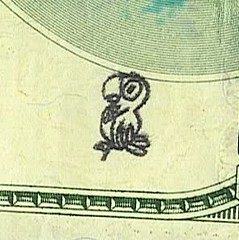
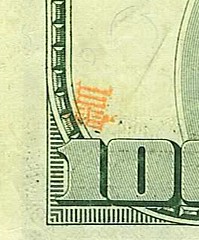
To read the complete article, see: A Study In Modern Chop Marks (www.coinpeople.com/index.php/topic/8551-a-study-in-modern-chop-marks/)

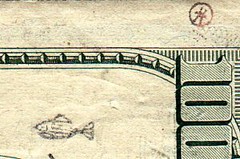
To read the complete article, see: More Chops (Stamps and Marks on Currency) (justteejay.wordpress.com/2012/02/21/more-chops-stamps-and-marks-on-currency/)

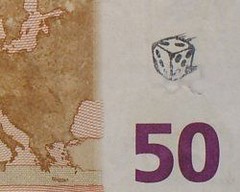
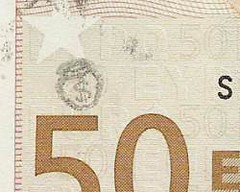
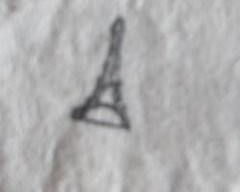
To read the complete article, see: Chopmarks on euro banknotes (home.wanadoo.nl/wasmyweb/ebt/fotogallery/stempels_klein.htm)
THE BOOK BAZARRE
2015 AMERICA THE BEAUTIFUL COIN DESIGNS
For 2015, the five national sites to be honored include:
- Homestead National Monument of America in Nebraska
- Kisatchie National Forest in Louisiana
- Blue Ridge Parkway in North Carolina
- Bombay Hook National Wildlife Refuge in Delaware
- Saratoga National Historical Park in New York
The Secretary of the Treasury will choose the final five designs. Before that can happen, the design candidates will be sent for review and comment to the chief executive of the site’s jurisdiction (State/District of Columbia/Territory), the Commission of Fine Arts (CFA), and the Citizens Coinage Advisory Committee (CCAC). Their comments will be taken into consideration before Mint official’s make a final recommendation and requesting the Secretary’s decision.

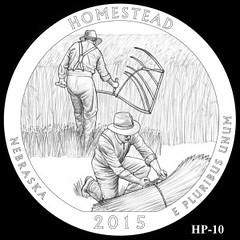
Homestead National Monument Design Candidates
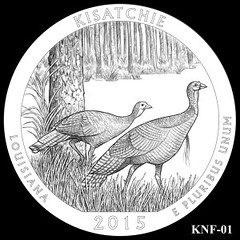
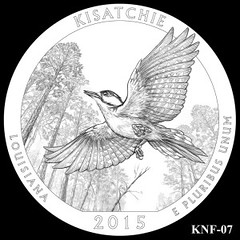
Kisatchie National Forest Design Candidates
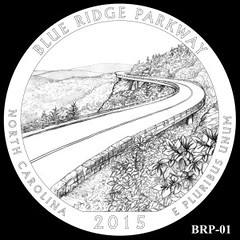
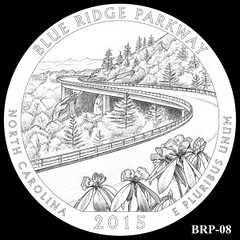
Blue Ridge Parkway Design Candidates
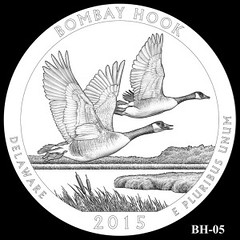
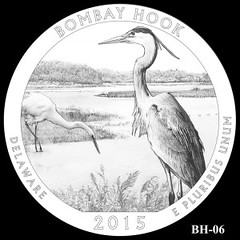
Bombay Hook National Wildlife Refuge Design Candidates
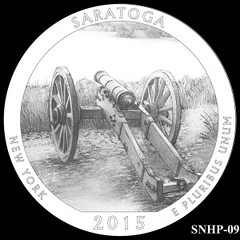
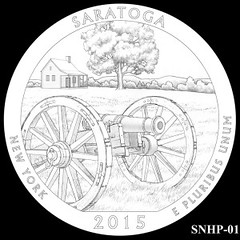
Saratoga National Historical Park Design Candidates
To read the complete article, see: Proposed Designs for 2015 America the Beautiful Silver Coins (www.silvercoinstoday.com/proposed-designs-for-2015-america-the-beautiful-silver-coins/109777/)
COMMEMORATIVES AND RELATED SO-CALLED DOLLARS
It is said that New York coin dealer Thomas Elder first coined the term “So-Called Dollar” to describe a medal sold at the 1904 Louisiana Purchase Exposition – an event better known as the St. Louis World’s Fair. Coin-like souvenirs such as that medal had been a staple at the many great expositions of the 19th and 20th centuries, not only capturing moments in time, but also telling the story of American industrial, technological, and cultural development.
These so-called dollars were diverse in design and theme, and for many Americans they were a physical embodiment of the memories that they would take from these great spectacles. For those that experienced these expositions, souvenirs like so-called dollars symbolized hope, optimism, and participation in the success and growth of America.
As the age of the Great American Expo came to an end, a growing sentiment for these souvenirs began to take shape. And for some, the emphasis was on so-called dollars. Their profile was greatly elevated with the publication in 1963 of So-Called Dollars: An Illustrated Standard Catalog, written by Harold E. Hibler and Charles V. Kappen.
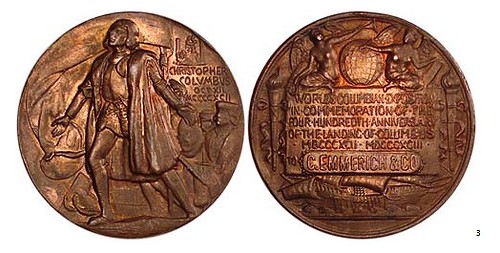 HK:223 by Augustus Saint-Gaudens and Charles Barber
HK:223 by Augustus Saint-Gaudens and Charles Barber
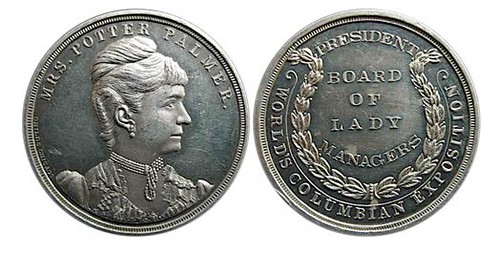 HK-243c: Bertha Honoré Palmer
HK-243c: Bertha Honoré Palmer
In the first part of our story, we discussed a number of so-called dollars and commemorative coins issued during important national and international expositions, including the World’s Columbian Exposition of 1893, the Louisiana Purchase Exposition of 1904, and the Panama-Pacific Exposition of 1915.
In this second part, we look at five interesting so-called dollar designs that are directly related to classic commemoratives that celebrate the same event. Some of them competed directly with the federally-issued coins. Many of them feature similar design motifs to those found on the official commemoratives, or at least found in proposals for their designs. These so-called dollars are essential collectors’ items, and their story is worth telling.
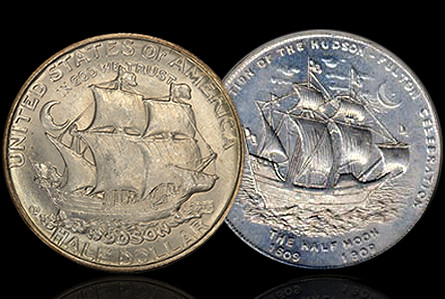
The classic commemorative series is awash with ships, none of them more stylized than Chester Beach’s rendering of the Half Moon. What’s interesting about the coin is that Beach’s Half Moon design is actually a redux of a design he used for bronze and aluminum medals struck by the Medallic Art Company for the 1609-1909 anniversary of the North American arrival of Henry Hudson’s Halve Maen. The Halve Maen (Half Moon) was secretly chartered by the Dutch to discover a direct route to China, but ended up near present-day New York (oops!).
Collectors of the Hudson half dollar, one of the more coveted pieces in the series, would be remiss not to seek out its nearly identical cousins HK-383 through 385, which feature the familiar Beach design on the obverse along with inscriptions reading “IN COMMEORATION OF THE HUDSON-FULTON CELEBRATION” and “THE HALF MOON 1609-1909”. The so-called dollar’s reverse features another memorable ship, Robert Fulton’s S. S. Clermont. The Clermont, also known as “Fulton’s folly” (and quite possibly never actually called the Clermont during Fulton’s life; that’s another story), was America’s first steam ship.
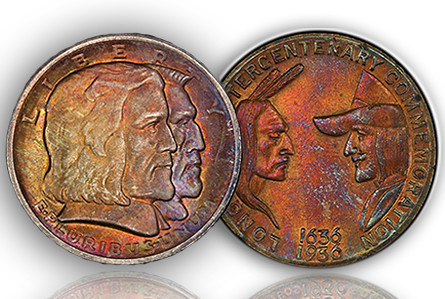
The 300th anniversary of the first European settlement on present day Long Island (derived from the Dutch Lange Eylandt) was cause for a large local celebration, held from May 30th to September 7th, 1936. The Committee in charge of the celebration sought Congressional approval for a commemorative coin that would help offset the costs. Legislation for the proposed half dollar was held up until a month before the celebration, and with the Mint backed up due to numerous other commemorative projects (1936 being the peak year for the series), reduction work on Howard Weinman’s models had to be done out of house at the Medallic Art Company. Delays in production meant that the coins would not be ready in time for the event.
With no coin to sell, organizers sought to issue a private medal. The Long Island Tercentenary Commemoration so-called dollar (HK694-694a) is struck on gilt copper and features the busts of a European settler and a Native American on the obverse. Unlike the coin, where the portraits are conjoined and face to the right, on the so-called dollar they face each other. The reverse features a federal eagle with a one star shield, fasces on both sides, and the inscriptions LONG ISLAND’S FIRST WHITE SETTLEMENT and 1636.
To read the complete articles, see:
Spotlight on So-Called Dollars
(www.coinweek.com/commemoratives/spotlight-on-so-called-dollars/)
To read the complete article, see: Early American Commemoratives, Part 2: Commemoratives and Related So-Called Dollars (www.coinweek.com/coin-guide/spotlight-called-dollars-2/)
SOTHEBY'S TO SELL BRITISH GUIANA ONE-CENT MAGENTA STAMP
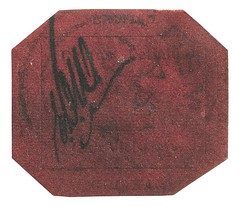 Sotheby’s New York will offer the most famous stamp in the world in a dedicated auction on 17 June 2014. No stamp is rarer than the sole-surviving example of the British Guiana One-Cent Magenta, a unique yet unassuming penny issue from 1856, and no stamp is more valuable: each of the three times it has been sold at auction, it has established a new record price for a single stamp. The British Guiana is equally notable for its legacy, having been rediscovered by a 12-year-old Scottish boy living in South America in 1873, and from there passing through some of the most important stamp collections ever assembled. The stamp comes to auction this spring with a pre-sale estimate of $10/20 million*, which would mark a new world auction record for a stamp**.
Sotheby’s New York will offer the most famous stamp in the world in a dedicated auction on 17 June 2014. No stamp is rarer than the sole-surviving example of the British Guiana One-Cent Magenta, a unique yet unassuming penny issue from 1856, and no stamp is more valuable: each of the three times it has been sold at auction, it has established a new record price for a single stamp. The British Guiana is equally notable for its legacy, having been rediscovered by a 12-year-old Scottish boy living in South America in 1873, and from there passing through some of the most important stamp collections ever assembled. The stamp comes to auction this spring with a pre-sale estimate of $10/20 million*, which would mark a new world auction record for a stamp**.
The British Guiana has not been on view publicly since the 1986, when it was exhibited at Ameripex ’86 International Stamp Show in Chicago. The stamp will travel this spring to locations including London and Hong Kong, before returning to New York for exhibition in Sotheby’s York Avenue galleries beginning 14 June.
The British Guiana is on offer from the estate of John du Pont – its most recent purchaser, in 1980 – and a portion of proceeds from the sale will benefit the Eurasian Pacific Wildlife Conservation Foundation, which du Pont championed during his lifetime.
In 1852, British Guiana began receiving regular postage stamps manufactured in England by Waterlow & Sons. But in 1856, a shipment of stamps was delayed, which threatened a disruption of postal service throughout British Guiana. The postmaster turned to the printers of the local Royal Gazette newspaper, and commissioned a contingency supply of postage stamps: the one-cent magenta, a four-cent magenta, and a four-cent blue.
The sole-surviving example of the one-cent magenta was first rediscovered not far from where it was initially purchased. In 1873, L. Vernon Vaughan, a 12-year-old Scottish schoolboy living with his family in British Guiana, found the stamp among a group of family papers bearing many British Guiana issues. A budding ‘philatelist’ (stamp collector), Vaughan could not have known the one-cent was unique, but he did know that he did not have an example, and added it to his album. He would later sell the stamp to another local collector in British Guiana, for several shillings.
The British Guiana One-Cent entered the UK in 1878, and shortly after, it was purchased by Count Philippe la Renotière von Ferrary, perhaps the greatest stamp collector in history. France seized his collection, which had been donated to the Postmuseum in Berlin, as part of the war reparations due from Germany, and sold the stamp in 1922 as one of a series of celebrated auctions from 1920–25. It was bought by Arthur Hind, a textile magnate from New York, for its first auction-record price of $35,000, followed by: Australian engineer Frederick T. Small; then a consortium headed by Irwin Weinberg; and lastly by John du Pont, heir to the eponymous chemical company fortune, eccentric amateur sportsman, and avid collector. Du Pont paid $935,000 for the stamp in a 1980 auction, marking the object’s most recent record-setting price.
To read the complete article, see:
Sotheby's to offer the world's most famous stamp: Estimated to sell for $10/20 Million
(artdaily.com/news/68178/Sotheby-s-to-offer-the-world-s
-most-famous-stamp--Estimated-to-sell-for--10-20-Million#.Uv-LAPmcJRQ)
EMPLOYMENT OPPORTUNITY!
Live and Work in Southern CaliforniaStack’s Bowers Galleries offers an important employment opportunity for the right person. We are seeking an experienced numismatist in the American series—coins, tokens, medals, and paper money—to work with our “dream team” of catalogers, building on the tradition of the Ford, Eliasberg, Bass, Cardinal, Norweb, Battle Born and other great collections.
If you can write in an authoritative and compelling manner with a high degree of accuracy, this may be just right for you! You will be working in Irvine, a modern community in dynamic Orange County, California—one of the finest areas to live. We offer generous benefits including medical and dental coverage, 401K plan, and more. Our offices are in our own modern, state-of-the art building with all amenities.
If you would like to be considered for this position please contact Q. David Bowers by mail or by email with your resumé, samples of your past writing (on numismatics or other subjects), and salary requirements: Mail to the attention of Q. David Bowers, PO Box 1804, Wolfeboro, NH 03894. Email to: Ckarstedt@stacksbowers.com
OSAMA BIN LADEN BANKNOTE
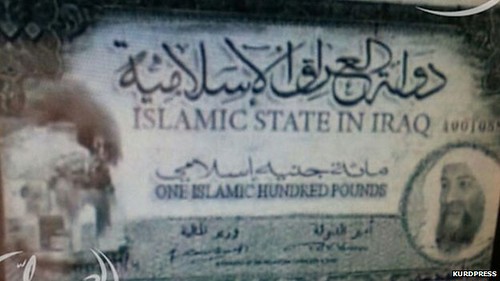
An extremist group operating in Iraq and Syria seems to have made a banknote bearing the image of Osama Bin Laden, in an apparent effort to declare sovereignty over areas in their control.
The note claims to be worth "one Islamic hundred pounds" and says in both English and Arabic it is from the Islamic State in Iraq, the Kurdpress news agency reports. But one expert talking to the Kuwaiti Al-Ra'y website said he was already suspicious about why the currency had been issued in pounds instead of Iraqi dinars, and added he did not think al-Qaeda would print English on its currency.
Meanwhile, Shafaq News in Baghdad points out the extremist group emerging in Iraq's western Anbar province is usually known by a different name - The Islamic State of Iraq and the Levant (ISIS).
The banknotes have not convinced pro-militant groups either. One group says in a Facebook post that the bills are a hoax meant to discredit the ISIS. "Look closely you'll see it's Photoshop," the group said, accusing local Sunni militias of "playing tricks".
We've also noticed the Bin Laden banknote has the same serial number - A001088 - as the Palestinian 100-pound note featured on Wikipedia.
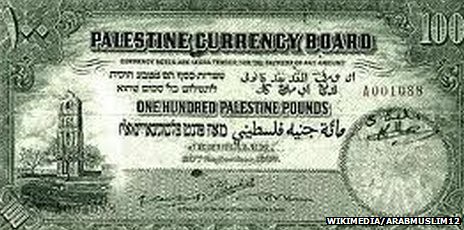
To read the complete article, see: Iraq: Has al-Qaeda issued a Bin Laden banknote? (www.bbc.co.uk/news/blogs-news-from-elsewhere-26153446)
ARTHUR HARRISON'S VICTORIA CROSS
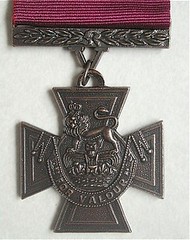 The only English rugby union player to win the Victoria Cross played his first game for his country on Valentine's Day 1914 and his valour echoes down the century.
The only English rugby union player to win the Victoria Cross played his first game for his country on Valentine's Day 1914 and his valour echoes down the century.
Members of this England team should be conscious that Friday marks the centenary of Arthur Harrison's debut for his country. They will know his name, given that it adorns an award bestowed among themselves for the finest defensive display in each match, but it is his record of valour – worthy of making him the only English rugby player to win the Victoria Cross – that underpins the head coach's desire to fortify a sense of national identity
The back-row forward provided, by all contemporary accounts, a sterling contribution in the scrum to mark his England debut on Feb 14, 1914, helping to ensure a 17-12 victory over Ireland on a Twickenham day free from any shadow of the impending cataclysm. A little over four years later he was dead, killed in the expedition to block the Bruges-Zeebrugge canal to German U-boats in a scene that one senior officer, Engineer Commander William Bury, described as a "bloody massacre". He was 33.
Harrison, a Lieutenant Commander aboard HMS Vindictive, had been taken for dead after the first rounds of merciless German fire, hauled below deck with a shattered jaw. But he was to astonish both his doctors and his men by re-appearing on deck, leading the landing party. In the act of conspicuous gallantry that would earn him the VC, and in spite of his agonies, he mobilised the attack, dying amid the ensuing slaughter along with all but two of his men. Alfred Carpenter, captain of Vindictive, would later recall that "Harrison's charge down that narrow gangway of death was a worthy finale to the large number of charges down many a rugby football ground".
To read the complete article, see:
England pay tribute to Great War hero Arthur Harrison VC on centenary of his Red Rose debut
(www.telegraph.co.uk/sport/rugbyunion/international/england
/10637683/England-pay-tribute-to-Great-War-hero-Arthur-Harrison-VC-on-centenary-of-his-Red-Rose-debut.html)
FEATURED WEB PAGE: LOVE TOKENS
This Valentine's week, our Featured Web Page is a blog post on Love tokens by Robyn Einhorn, of the Smithsonian's National Numismatic Collection.
How does a numismatist (person who studies currency) say "Happy Valentine's Day"? With a love token, of course!
Love tokens are coins that were engraved after the minting process was complete. Generally, an artisan removed the words and images from the reverse, or sometimes from both the obverse and the reverse of a coin. Artisans ranging in skills from a high-quality craftsperson to a "do-it-yourselfer" then engraved or punched pictures, initials, and messages on the cleared area.
Other times, the coin was left intact and the artisan engraved initials, dates, or pictures on the edges around the images of liberty or royalty. The coins became lucky charms, objects of art, and pieces of jewelry. The messages on the coins could be used as spiritual reminders, family documentation, or sentimental sweet nothings.
It is believed that the love token originated in Great Britain as early as the 13th century with the practice of bending coins. When dealing with your favorite saint, in return for a favor, a coin was bent and a pledge was made. The bent coin, "a token of your pledge," became a physical reminder of your obligation.
Because love tokens are hand-engraved, they are unique. The birth of a baby, the initial of your intended, a soldier leaving a memory of himself with his loved ones, or a prisoner getting sent off to do his time; all have been remembered on the surface of a coin.
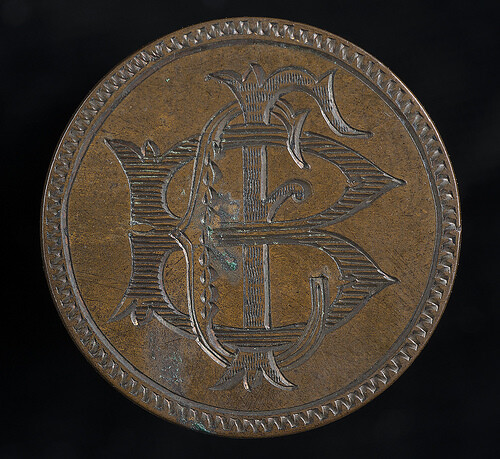
blog.americanhistory.si.edu/osaycanyousee/
2014/02/love-tokens-where-cold-hard-cash
-and-romance-meet.html

